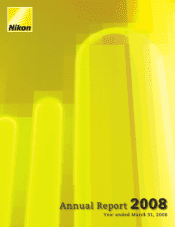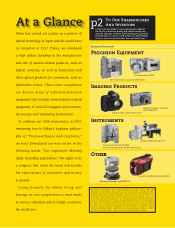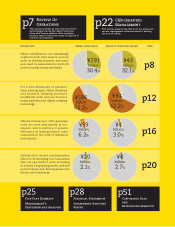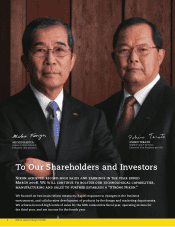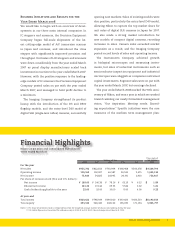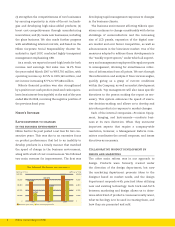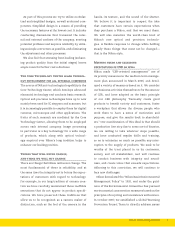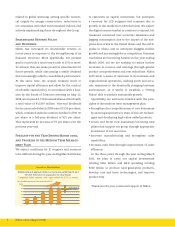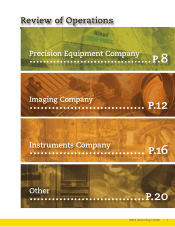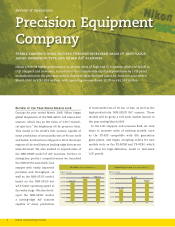Nikon 2008 Annual Report Download - page 7
Download and view the complete annual report
Please find page 7 of the 2008 Nikon annual report below. You can navigate through the pages in the report by either clicking on the pages listed below, or by using the keyword search tool below to find specific information within the annual report.
As part of this process we try to utilize modular-
ized and simplified designs, as well as shared com-
ponents. Simplified design is a means of providing
the necessary features at the lowest cost. It includes
conducting discussions that transcend the inter-
nal and external confines of the company, averting
potential problems and improve reliability by utiliz-
ing as simple a structure as possible, and eliminating
the adjustment and other processes.
We also feel that stressing front-loading (enhanc-
ing product quality from the initial stages) leaves
ample room for further cost reductions.
The Core Technology Center leads technol-
ogy development for all internal companies
The source of Nikon’s technological capability is the
Core Technology Center, which develops advanced
elemental technology and conducts basic research.
Optical and precision technologies have up to now
mainly been used for IC steppers and scanners, but
it is increasingly possible to employ these for digital
cameras, microscopes and other applications. The
fruits of such research are mediated by the Core
Technology Center, allowing them to be employed
across each internal company. Image processing
in particular is a key technology for a wide range
of products, which along with optical technol-
ogy acquired over Nikon’s long tradition helps to
enhance our leading position.
Things that will never change,
and those we will not change
There are things that Nikon will never change. The
most fundamental of these is reliability, and at
the same time t he integ rit y not to betray t he expec-
tations of customers with regard to technology.
For example, in our long tradition of camera crea-
tion we have carefully maintained those ineffable
sensations that do not appear in product specifi-
cations. We have preserved those traditions that
allow us to be recognized as a camera maker of
distinction, such as the feel of the camera in the
hands, its texture, and the sound of the shutter.
We believe it is important to respect the idea
that customers have certain expectations when
they purchase a Nikon, and that we meet them.
We will also maintain the world-class level of
Nikon’s core optical and precision technolo-
gies. A flexible response to change while holding
steady those things that must not be changed—
that is the Nikon style.
Meeting needs and exceeding
expectations in CSR as well
Nikon made “CSR-oriented management” one of
its priority measures in the medium term manage-
ment plan announced in March 2006, and devel-
oped a variety of measures based on it. We consider
our business activities themselves to be the essence
of CSR, and have adopted as the basic principle
of our CSR philosophy “Earnestly create good
products to benefit society and customers, foster
a workplace that allows the diverse people who
work there to have a sense of motivation and
purpose, and give the results back to sharehold-
ers.” One manifestation of this ideal is that should
a production line stop due to some sort of disaster,
we are willing to take whatever steps possible,
and have conducted regular drills and training,
so as to minimize as much as possible any inter-
ruption to the supply of products. We seek to be
worthy of the trust placed in us by customers,
society and all stakeholders, and will continue
to conduct business with integrity and sound-
ness, and create value that exceeds expectations.
Adhering to this conviction, we will continue to
face new challenges.
Nikon formulated the “Nikon Basic Environmental
Management Policy” in 1992, and under the guid-
ance of the Environmental Committee has pursued
environmental conservation measures based on the
principles of recycling and coexistence with nature.
In October 2007, we established a Global Warming
Prevention Project Team to directly address issues
Nikon Annual Report 2008 5

